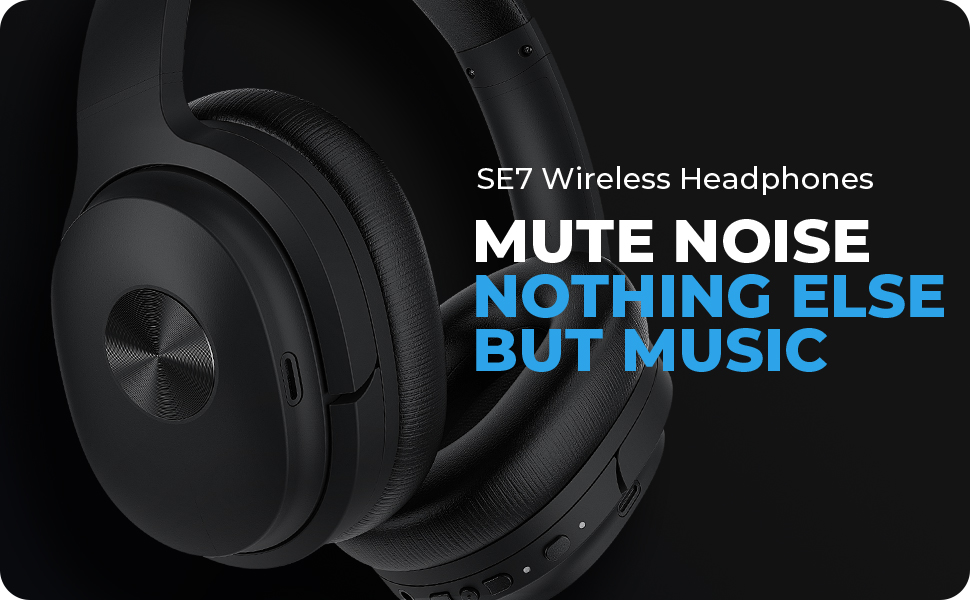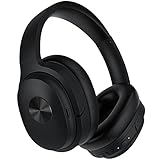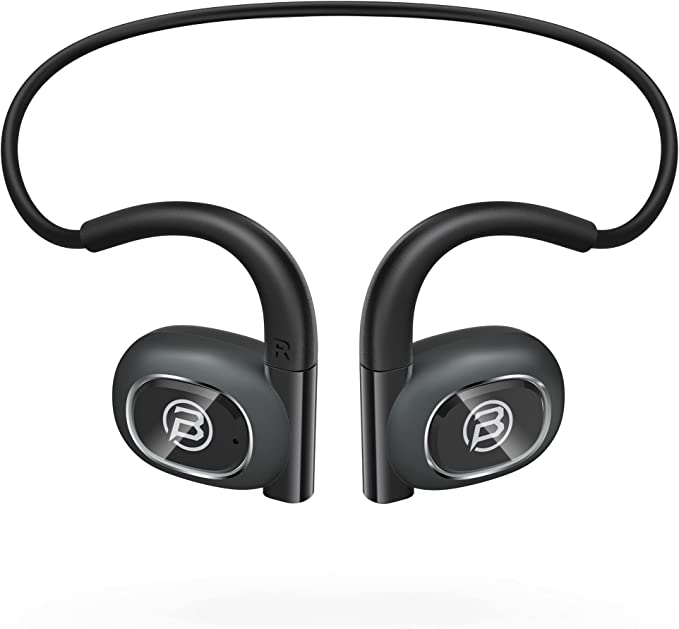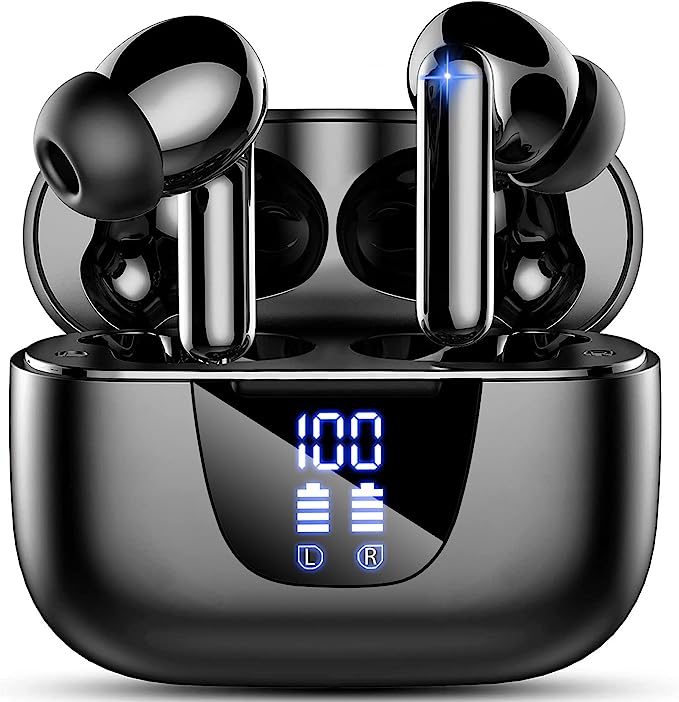Our world is a symphony, often a cacophonous one. From the rumble of city streets to the incessant chatter of open-plan offices, our brains are constantly working to filter, to focus, to find a semblance of clarity amidst the din. In this quest for auditory control, personal audio devices, especially headphones, have evolved from simple earpieces into sophisticated havens of sound, intricate marvels of applied science. They are our personal concert halls, our quiet libraries, our direct lines of communication in an ever-busier world.
Today, we’ll embark on an exploration, not just of a product, but of the fascinating science that makes such personal audio experiences possible. Our “specimen” for this journey is the phonicgrid SE7 Wireless Headphones. By dissecting its features, as described by its creators, we can unveil the elegant principles of physics, engineering, and psychoacoustics that empower you to curate your own soundscape. So, settle in, and let’s decode the whispers of science that enable the roars, and the silences, of modern sound.

Sculpting Silence – The Enigma of Active Noise Cancellation
One of the most sought-after features in modern headphones is the almost magical ability to hush the world around us. We’ve all felt it: that persistent, low-frequency hum of an airplane cabin, the drone of office air conditioning, or the distracting rumble of a commuter train. These sounds, often relentless and pervasive, can sap our energy and shatter our concentration. The phonicgrid SE7 headphones claim to tackle this head-on with “Enhanced active noise technology,” aiming to reduce “up to 95% of low-frequency noises around you.” (Source: Provided Text). But how does one actually cancel sound?
The science, while complex in execution, is beautifully elegant in principle. Sound travels in waves, characterized by peaks and troughs. Imagine dropping two pebbles into a still pond; ripples spread outwards. If the peak of one ripple meets the trough of another identical, opposing ripple, they cancel each other out, and the water surface becomes momentarily flat at that point. This is called destructive interference. Active Noise Cancellation (ANC) in headphones like the SE7 employs this very principle, but with sound waves.
Here’s a simplified look at how it likely works within the “hybrid active noise cancelling” system the SE7 is said to feature (Source: Provided Text):
- Listening to the Enemy: Tiny microphones are strategically placed on the outside of the earcups. These are the sentinels, constantly listening to the ambient noise encroaching upon your personal space. This is often called the “feed-forward” part of a hybrid system.
- Internal Check-up: Another set of microphones inside the earcups listens to what you are actually hearing, including any residual noise and the audio you want to hear. This “feed-back” mechanism allows the system to fine-tune its efforts.
- The Counter-Attack: This is where the “brain” of the operation, a sophisticated Digital Signal Processor (DSP), comes into play. It instantaneously analyzes the unwanted noise signals captured by the microphones. With incredible speed and precision, it generates a new sound wave that is the exact mirror image – or “anti-phase” – of the external noise.
- The Sound of Silence (Almost): This “anti-noise” is then played through the headphone’s own speakers. When the original invading noise wave and this precisely crafted anti-noise wave meet at your eardrum, they effectively neutralize each other.
It’s a constant, high-speed dance of detection, analysis, and counter-signal generation. This is why ANC is particularly effective against those persistent, predictable low-frequency sounds. The longer wavelength of these sounds gives the system more time to react. Sudden, sharp noises like a door slam or a nearby conversation are trickier, as their wave patterns are more complex and less predictable, though ANC systems are continually improving.
The benefit for the user of the phonicgrid SE7, should its ANC perform as described, extends far beyond mere quiet. It’s about creating a sanctuary. In that hushed environment, music gains depth and detail, podcasts become more engaging, and focused work becomes more attainable. Imagine transforming a roaring train commute into a serene space for reading, or an open-plan office, with its myriad distractions, into a focused work bubble where your thoughts can flow uninterrupted. The reduced cognitive load from constantly battling background noise can also lead to less fatigue over long periods. Indeed, many users find effective “noise cancellation” to be a game-changer for productivity and relaxation.

“Can You Hear Me Now?” – The Delicate Art of Voice Clarity with ENC
In our hyper-connected world, clear communication is paramount. Whether it’s a crucial business call, a virtual family gathering, or a quick chat with a friend, being heard accurately, without the intrusion of your surroundings, is essential. Yet, how often have you struggled to hear someone over the clatter of a coffee shop, or apologized for the wind noise on your end? The phonicgrid SE7 product information highlights “premium built-in microphones and ENC technology” designed for “crystal clear and stable hands-free calls.” (Source: Provided Text). This Environmental Noise Cancellation (ENC) is a distinct technology from ANC, though they both strive to manage unwanted sound.
While ANC focuses on creating a quiet listening experience for you, ENC is all about ensuring your voice is transmitted cleanly to the person on the other end of the call. Think of it as an intelligent filter for your microphone. Here’s the general idea:
- Targeted Listening: ENC systems often utilize multiple microphones. These microphones work in concert, sometimes employing a technique called “beamforming.” Imagine these microphones creating an invisible cone, or “beam,” that preferentially listens in the direction of your mouth. Sounds originating from outside this beam – like side conversations or traffic noise – are picked up with less intensity.
- Algorithmic Sifting: Sophisticated algorithms within the headphone’s processor then analyze the signals from these microphones. These algorithms are trained to distinguish the characteristics of human speech from various types of environmental noise. They effectively “sift” through the audio landscape, identifying your voice and attenuating the surrounding clamor.
- Clean Feed Forward: The result is that the audio signal sent to your caller is primarily your voice, with significantly reduced background interference.
It’s a clever piece of audio engineering. The SE7’s claim of “premium built-in microphones” (Source: Provided Text) is crucial here, as the quality of the initial voice capture is fundamental to any subsequent processing. Good microphones provide a cleaner signal for the ENC algorithms to work with.
The value of effective ENC, as proposed for the SE7, is immediately apparent. It’s the confidence of knowing you can take an important call from a bustling airport gate, and your voice will cut through the announcements with clarity. It’s the professionalism conveyed when your colleagues hear your insights, not the blare of the TV in the next room during a work-from-home meeting. One user review from the provided text even noted the SE7’s “microphone is MUCH BETTER” than a previous, more expensive pair of headphones (Source: Provided Text), underscoring the impact this technology can have. For anyone who relies on their headphones for communication, ENC isn’t just a feature; it’s a necessity for clear, stress-free conversations.
The Unseen Tether – Navigating the Airwaves with Bluetooth 5.2
The dream of truly untethered audio has been a long-held aspiration. Who doesn’t remember the frustration of headphone cables snagging on doorknobs or getting hopelessly tangled in a bag? Wireless technology, particularly Bluetooth, has largely liberated us from this. The phonicgrid SE7 headphones utilize “Bluetooth 5.2” for their wireless connectivity (Source: Provided Text). But what does this number mean, and how does this unseen tether work its magic?
Bluetooth, named rather poetically after the 10th-century Danish king Harald Bluetooth who united warring factions, is a wireless technology standard for exchanging data over short distances using UHF radio waves. It’s the invisible handshake that connects your SE7 headphones to your phone, laptop, or tablet. Each new version of Bluetooth typically brings improvements, and Bluetooth 5.2, a relatively recent iteration, offers several general enhancements over its predecessors:
- Enhanced Data Throughput & Range: While specific range is always environment-dependent, Bluetooth 5.2 generally allows for faster data transfer and potentially more robust connections over greater distances than older versions. For audio, this can mean a more stable stream with fewer dropouts.
- Improved Power Efficiency: This is a significant one. Bluetooth 5.2 includes features that help devices consume less power. For battery-operated devices like the SE7 headphones, which boast “30 Hours for Listening” (Source: Provided Text), this efficiency is crucial. Technologies like LE Audio (Low Energy Audio), which is a cornerstone of Bluetooth 5.2, are designed to deliver high-quality audio at lower power consumption.
- Better Coexistence: Bluetooth operates in a busy 2.4 GHz radio band, shared with Wi-Fi and other devices. Newer Bluetooth versions have improved mechanisms for “channel hopping” and interference avoidance, leading to more stable connections even in crowded radio environments.
- Isochronous Channels: A key feature introduced in Bluetooth 5.2 is support for LE Isochronous Channels. This allows for time-synchronized data streaming to multiple devices, which is foundational for next-generation Bluetooth audio features like Auracast™ broadcast audio (though whether the SE7 specifically implements such features is not detailed in the provided text, the underlying standard supports it).
For the phonicgrid SE7 user, these technical advancements translate into a more seamless and reliable wireless experience. It’s the freedom to move around your home while your phone charges, the convenience of pairing quickly with your devices, and the confidence that your music or call won’t be abruptly interrupted. It’s the unseen dance of radio waves, meticulously choreographed by standards like Bluetooth 5.2, that makes wireless audio not just possible, but a dependable part of our daily lives.

The Soul of the Sound – Understanding Drivers and Audio Fidelity in the SE7
At the very heart of any headphone, the component responsible for transforming electrical signals into the sound waves that grace our ears, is the driver. The quality, design, and size of these drivers are paramount to the audio fidelity you experience. The phonicgrid SE7 headphones are equipped with “40mm Large Aperture Drivers” and feature an “advanced speaker diaphragm and chip,” all aimed at delivering “impeccable sound quality” where “every detail of audio” is transmitted perfectly (Source: Provided Text).
Let’s peer inside this sonic engine. Most headphones, including likely the SE7, use dynamic drivers. Imagine a miniature, high-precision loudspeaker:
- The Magnet: A fixed permanent magnet creates a magnetic field.
- The Voice Coil: A lightweight coil of fine wire is attached to the diaphragm and sits within this magnetic field. When the audio signal (an electrical current) flows through this coil, it becomes an electromagnet.
- The Diaphragm: This is a thin, semi-rigid membrane. As the voice coil interacts with the permanent magnet (attracting and repelling based on the audio signal’s current), it rapidly moves back and forth, pushing and pulling the attached diaphragm with it.
- Making Waves: The diaphragm’s vibrations displace the air, creating sound waves that travel to your eardrum.
The “40mm Large Aperture” designation for the SE7’s drivers refers to the diameter of the diaphragm. Generally, a larger diaphragm can move more air. This is particularly beneficial for reproducing lower frequencies – the bass and sub-bass that give music its warmth and impact – with less effort and potentially less distortion. It allows for those satisfying rumbles and thumps without sounding muddy or strained.
The “advanced speaker diaphragm” mentioned for the SE7 is also critical. The material, stiffness, lightness, and damping properties of the diaphragm significantly influence how accurately it can vibrate across the entire audible spectrum (roughly 20 Hz to 20,000 Hz for humans). An ideal diaphragm should be light enough to respond quickly to rapid changes in the audio signal (for clear treble) yet rigid enough to avoid flexing or “breaking up” at high volumes or during complex passages (which causes distortion). Engineers experiment with various materials, from treated paper and plastics to exotic composites and metals, to achieve the desired acoustic properties.
Finally, the “chip” mentioned alongside the diaphragm in the SE7’s description likely refers to the integrated Digital-to-Analog Converter (DAC) and amplifier circuitry. In wireless headphones, the digital audio signal received via Bluetooth must be converted back into an analog electrical signal by the DAC, and then this analog signal must be amplified by the amplifier to provide enough power to drive the voice coils. The quality of these components is crucial; a poor DAC or a noisy amplifier can degrade the sound before it even reaches those 40mm drivers.
The goal of all this intricate engineering, as Phonicgrid states, is to “transmit every detail of audio to your ears perfectly, so you can hear your music exactly as it was intended to be heard.” (Source: Provided Text). For the listener, this means the potential for a richer, fuller, more engaging audio experience – hearing the subtle breath of a singer before a phrase, the distinct timbre of individual instruments in an orchestra, or the clean, impactful punch of a kick drum. As one user from the provided source noted, the SE7’s sound is “extremely clear and BALANCED which is a rarity among headphones (most catering to the low end)” (Source: Provided Text). This suggests an attention to tuning that aims for fidelity across the spectrum, not just an overemphasis on one area.
The Endurance Athlete – Marrying Extended Playtime with Ergonomic Grace
A truly exceptional audio experience can be quickly undermined if your headphones die mid-journey or become an instrument of torture after an hour of wear. Recognizing this, modern headphone design increasingly focuses on two critical aspects: battery endurance and ergonomic comfort. The phonicgrid SE7 seems to embrace this philosophy, promising “30 Hours for Listening” on a full charge and featuring a “Lightweight design” with “super imitation protein leather” for a “no-pressure and comfortable fit.” (Source: Provided Text).
Thirty hours of continuous music playback is a significant claim and speaks to advancements in several areas. Firstly, battery technology itself, primarily lithium-ion and lithium-polymer cells, has seen remarkable improvements in energy density – meaning more power can be packed into smaller, lighter packages. Secondly, the power efficiency of the components within the headphones plays a huge role. This includes the Bluetooth 5.2 chip we discussed earlier, with its low-energy protocols, as well as efficient amplifier designs and even the power management of the DSP. Every milliamp saved contributes to that marathon listening capability.
But what good is a long-lasting battery if the headphones are unbearable to wear? This is where ergonomics and material science step in. The SE7’s “Over Ear” form factor is generally preferred for comfort during extended use, as it distributes pressure around the ear rather than directly on it. Key elements in achieving that “no-pressure and comfortable fit” include:
- Weight and Distribution: A “lightweight design” (Source: Provided Text) is crucial. The overall mass and how that weight is distributed across the adjustable headband determine how much strain is placed on your head and neck.
- Clamping Force: This is the pressure the earcups exert against your head. Too little, and the headphones will feel loose and lack a good seal (important for bass response and passive noise isolation). Too much, and they’ll quickly become uncomfortable. Finding the right balance is key.
- Earcup Design and Material: The “super imitation protein leather” (Source: Provided Text) used on the SE7’s earcups aims to provide a soft, pliable contact surface. Good quality earpad materials can also offer some breathability to reduce heat buildup, a common complaint with over-ear designs during long sessions. The shape and depth of the earcups also matter, ensuring enough room for the ears without pressing against them.
- Adjustability: An “Adjustable headband” (Source: Provided Text) allows users to customize the fit to their specific head size and shape, ensuring the earcups are positioned correctly and the weight is distributed evenly.
Phonicgrid states their design goal is “ultimate comfort and relaxation,” enabling them to be worn “all day long with ease.” (Source: Provided Text). Users from the provided text affirm this, with one stating they are “extremely comfortable even during long periods of use” and “much more comfortable, much lighter” than a previous pair (Source: Provided Text). Another user simply mentioned they are “super comfortable” (Source: Provided Text).
For the user, these considerations mean the freedom to immerse themselves in audio for the duration of a transatlantic flight, get through an entire workday of calls and focus-enhancing music, or indulge in extended gaming or movie sessions without constantly being reminded of the hardware on their head or an impending low-battery warning. It’s about making the technology feel almost invisible, allowing the audio experience to take center stage. The SE7 package also includes a “portable case,” (Source: Provided Text) a practical addition for protecting this carefully designed comfort and technology on the go. It’s also worth noting a practical detail from the user Q\&A: these headphones apparently “cannot use while charging” (Source: Provided Text, Q\&A answer by Max in GJ, CO), which is a common characteristic but good to be aware of for planning usage.

Coda: The Orchestra of Innovation in Your Ears
As we draw this exploration to a close, it’s clear that a device as seemingly straightforward as a pair of headphones – exemplified here by the phonicgrid SE7 – is, in reality, a complex symphony of scientific disciplines. From the wave physics of active noise cancellation and the intricate signal processing for call clarity, to the radio engineering of Bluetooth, the electromechanical artistry of audio drivers, and the ergonomic considerations of long-term comfort, each element plays a crucial role.
The phonicgrid SE7, with its stated features like “enhanced active noise technology,” “ENC technology,” “40mm Large Aperture Drivers,” “Bluetooth 5.2,” and a “30 Hours for Listening” capability (Source: Provided Text), serves as a tangible example of how these diverse technologies converge. Phonicgrid’s own stated goal “to best-class active noise cancelling headphones” and to “Harvest smiles of customers” (Source: Provided Text) reflects the ambition inherent in this field.
Beyond the specifications and marketing claims of any single product, the true marvel lies in the accessibility of such sophisticated engineering. The relentless pursuit of better sound, clearer communication, and greater comfort continues to drive innovation. Hopefully, this journey through the science inside has not only demystified some of the technology you use every day but has also fostered a deeper appreciation for the ingenuity orchestrated within the compact confines of your headphones. May your listening, informed by this understanding, be ever more enlightened and enjoyable.




